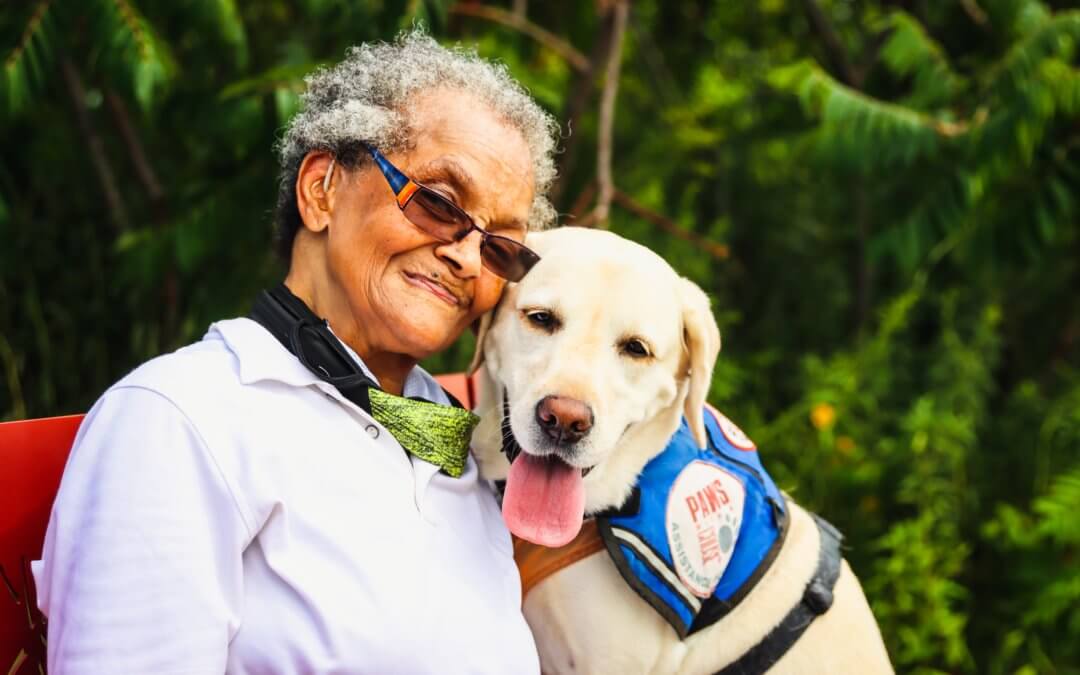Evidence of service dogs assisting humans who are facing challenges to gain their independence goes back centuries. A fresco discovered in the ruins of the ancient Roman city Herculaneum and dating to the first century A.D. depicts a blind person being led by a dog. Similar images of dogs leading the blind have been found in European and Chinese art created in the middle ages.
A dog named Buddy, who was trained in Switzerland, is believed to be the first American guide dog. His trainer, Dorothy Eustis, and the blind man Buddy was trained to assist, Morris Frank, founded the guide dog school The Seeing Eye in Tennessee in 1929. Today, service dogs are trained to help people with a variety of physical and mental challenges. It is estimated that 500,000 service dogs assist people with disabilities in the United States.
Despite their long history and the prevalence of service dogs in American society, many people are unaware of the laws applicable to service dogs. This article will provide an overview of the rules pertaining to public access for service dogs under the federal Americans with Disabilities Act (ADA).
The ADA was enacted in 1990 and is enforced by the U.S. Department of Justice. Title II, subtitle A of the ADA prohibits public entities, such as state or local government, from discriminating against persons with disabilities. Title III of the ADA protects persons with disabilities from discrimination by places of public accommodation and commercial facilities, such as restaurants, hotels, and stores. The public places a person with a service dog is allowed to go are determined by the ADA and its related regulations.
The regulations implementing Title II and Title III of the ADA define a service animal as “any dog that is individually trained to do work or perform tasks for the benefit of an individual with a disability, including a physical, sensory, psychiatric, intellectual, or other mental disability.” (While this article focuses on service dogs, the ADA regulations in 28 C.F.R. § 35.136(i) and 28 C.F.R. 36.302(c)(9) also recognize the use of miniature horses that have been trained to perform tasks on behalf of a disabled person so long as certain criteria are met.) The ADA does not restrict the definition of service dog by breed.
The key portion of the definition is that the animal be trained to do work or perform tasks on behalf of a disabled person. “The crime deterrent effects of an animal’s presence and the provision of emotional support, well-being, comfort, or companionship do not constitute work or tasks for the purposes of this definition.”
Public entities and places of public accommodation are not allowed to ask a person with a service dog about the nature or extent of his or her disability. The regulations do allow two inquiries to be made as to whether the dog qualifies as a service animal. It is permissible to “ask if the animal is required because of a disability and what work or task the animal has been trained to perform.” However, these questions may not be asked if it is obvious that the animal is providing service or performing tasks for a disabled person. Service dogs do not need to be professionally trained, and the regulations do not allow public entities and places of public accommodation to ask for documentation that the animal “has been certified, trained, or licensed as a service animal.” The ADA does not require that the service dog wear an identifying vest, tag, or badge.
The ADA regulations require a public entity or public accommodation to “modify its policies, practices, or procedures to permit the use of a service animal by an individual with a disability.” For example, a restaurant that has a “no pets” policy is required to make an exception to that policy for a service dog. While this is the general rule, there are general defenses to the ADA and modifications need not be made if the entity can demonstrate that: (1) such modifications would fundamentally alter the nature of the entity’s goods, services, facilities, privileges, advantages, or accommodations; (2) the safe operation of the entity would be jeopardized; or (3) such modifications would result in an undue financial or administrative burden.
Barring these exceptions, a public entity must allow a person with a disability who has a service dog “in all areas of a public entity’s facilities where members of the public, participants in services, programs or activities, or invitees, as relevant, are allowed to go.” Places of public accommodation must allow a disabled person accompanied by a service dog “in all areas . . . where members of the public, program participants, clients, customers, patrons, or invitees, as relevant, are allowed to go.” The dog’s handler is responsible for supervising or caring for the service dog. Neither a public entity nor a public accommodation may ask or require an individual with a disability to pay a surcharge, even if people accompanied by pets are required to pay fees, or to comply with other requirements generally not applicable to people without pets. If a public accommodation normally charges individuals for the damage they cause, an individual with a disability may be charged for damage caused by his or her service animal.
There are two situations in which a public entity or a public accommodation may request that a disabled person remove his or her service animal from the premises. The first is when “(t)he animal is out of control and the animal’s handler does not take effective action to control it.” Regulations require that:
[a] service animal shall be under the control of its handler. A service animal shall have a harness, leash, or other tether, unless either the handler is unable because of a disability to use a harness, leash, or other tether, or the use of a harness, leash, or other tether would interfere with the service animal‘s safe, effective performance of work or tasks, in which case the service animal must be otherwise under the handler’s control (e.g., voice control, signals, or other effective means).
The second situation in which a service animal may be legally excluded is when “(t)he animal is not housebroken.”
A public entity that legally excludes a service animal must give the disabled person “the opportunity to participate in the service, program, or activity without having the service animal on the premises.” If a public accommodation properly excludes a service animal, it is required to “give the individual with a disability the opportunity to obtain goods, services, and accommodations without having the service animal on the premises.”
If a person with a service dog believes he or she has been discriminated against in violation of the ADA, he or she may file a complaint with the U.S. Department of Justice or file a federal lawsuit.
Other federal statutes, such as the Fair Housing Act and the Air Carrier Access Act, and state law also apply to service animals. The rules and regulations, starting with the definition of a service animal, are not universal or consistent, contributing to the confusion regarding the correct response to service animals. Please look for future articles exploring some of the other rules regarding service animals. We are going to keep working to improve animal welfare and serving as a voice for the animals through advocacy. Together, we can continue to make a difference in animals’ lives.
If you know someone who you think would be interested in this information, please share and sign up for our Legislative Action Network.
Photo credit: Provisionshots, Pexels

